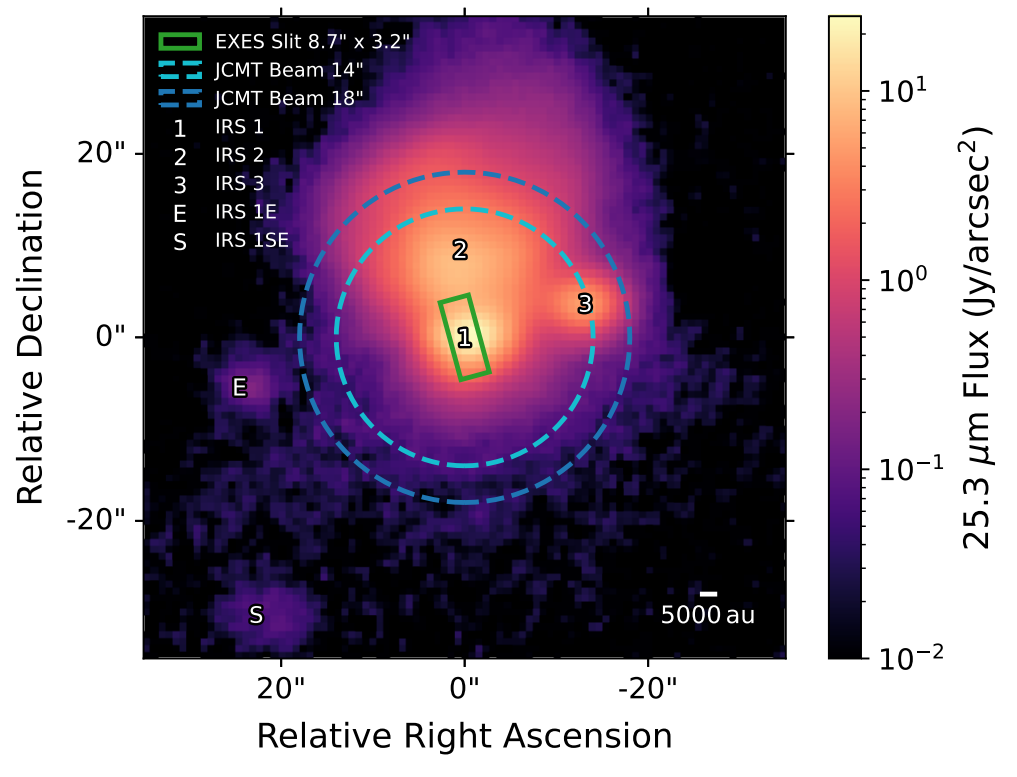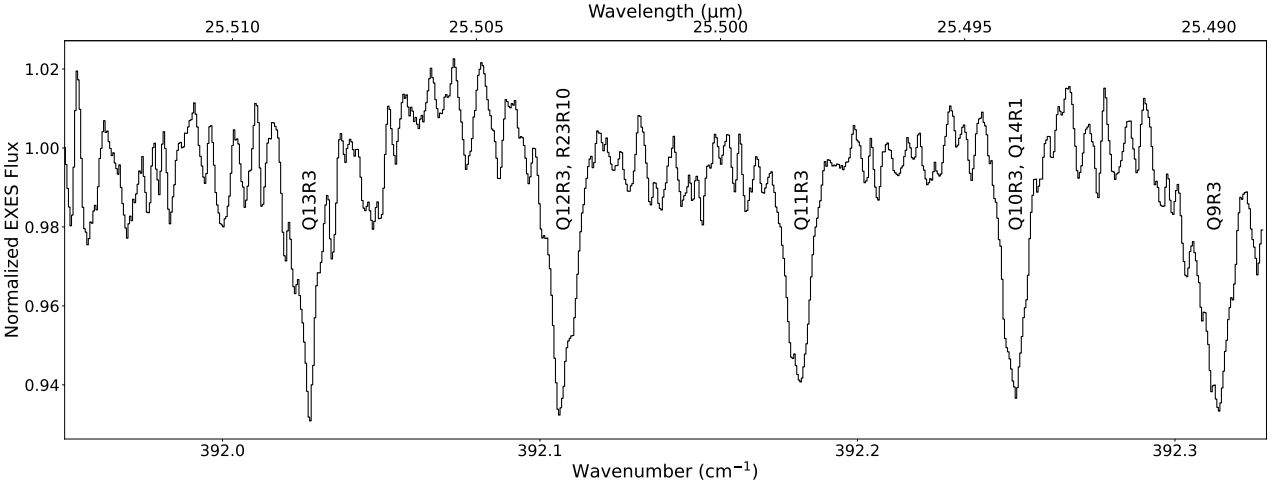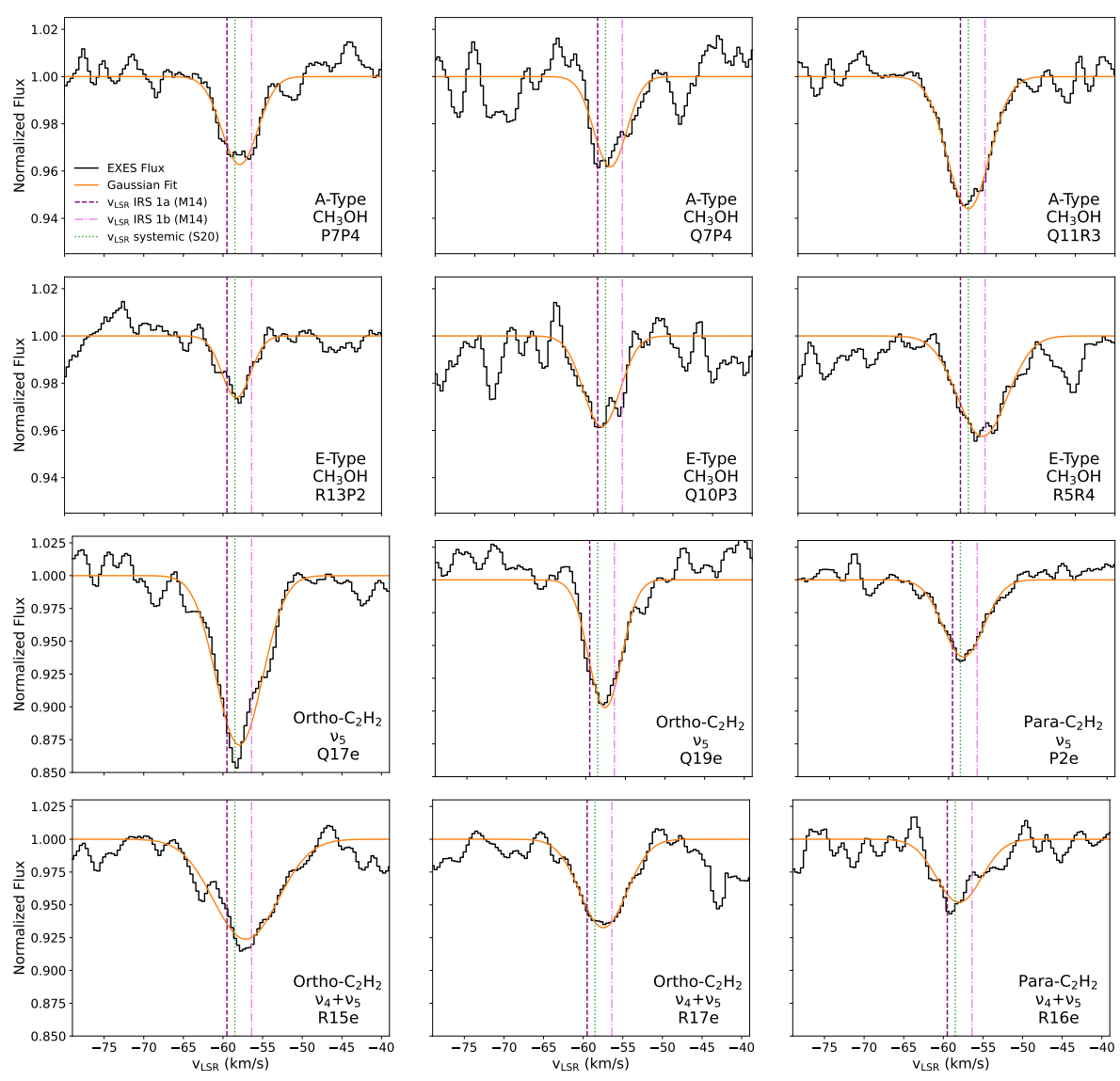Methanol (
A new study reports the first astrophysical detection of methanol in its torsional band near 25 micrometers, identified in high resolution mid-infrared spectra toward the massive protostar system NGC 7538 IRS 1 using the EXES spectrograph on the airborne SOFIA observatory.
The team fits more than seventy gas-phase
The work matters beyond a single source. The authors release an updated 25 um
Key takeaways
- First interstellar detection of \(CH_3OH\) 25 um torsional band using SOFIA/EXES, with >70 absorption lines identified.
- Derived gas properties toward NGC 7538 IRS 1: T ~ 180 K, N(
) ~ ; E- over A-type ratio ~ 1.43, hinting at non-equilibrium processing. - A complementary analysis of
shows similar velocities but higher temperatures (~300 K), pointing to stratified layers in the same component. - Unresolved second velocity component appears in both species, consistent with two edge-on disks and a multi-protostar system.
- The 25 um band is likely the only practical mid-IR route for
with JWST/MIRI because the 9-10 um region is blended with S(3) H2 transition and is suppressed by silicates (Gordon et al., 2022). - Updated
line list near 25 um will aid searches in MIRI spectra and enable better modeling of disk chemistry.
How the detection works
EXES is a cross-dispersed echelle spectrograph capable of high spectral resolution in the mid-IR when flown on SOFIA (Stratospheric Observatory for Infrared Astronomy high altitude airliner) above most atmospheric water vapor (Richter et al., 2018; Young et al., 2012).
At R ~ 60,000 the authors could isolate individual
They then constructed rotation diagrams, assuming LTE populations and using updated partition functions and Einstein A coefficients, to estimate total column densities and excitation temperatures. The analysis was performed separately for A- and E-type methanol, which are distinct symmetry species with forbidden interconversion in the gas phase.
For IRS 1 the team finds T ~ 183 +/- 14 K and N ~
Why 25 um is special
JWST/MIRI delivers R ~ 1500-4000 in its medium resolution integral-field spectroscopy mode, which is generally insufficient to separate many individual mid-IR molecular lines in crowded regions.
For
The 25 um torsional band, by contrast, emerges in a cleaner part of the spectrum and appears rich in discrete transitions even at moderate resolution. This makes it a practical target for

Figure 1. 25.3 µm map of the NGC 7538 region from SOFIA/Faint Object infraRed Camera (FORCAST; Herter et al. 2013) archival data (Cycle 1 Program 0034, PI A. G. G. M. Tielens). Our target and brightest source, IRS 1, is at the centre with offset 0′′, 0′′ corresponding to α(J2000) = 23:13:45.37, δ(J2000) = +61:28:10.5. The positions of IRS 1 and the dimmer sources (IRS 2, IRS 3, IRS 1E, and IRS 1SE) are given by Sandell et al. (2020). In solid green is the 8.7′′×3.2′′ EXES slit from this work’s 23.9 µm setting (Table A1), and in dashed blue the 14′′ and 18′′ JCMT beams (van der Tak et al. 2000; Bisschop et al. 2007) whose CH3OH results we will use for a comparison (Section 5.1). au scale uses a distance of 2.65 kpc (Moscadelli et al. 2009). Note the logarithmic scale for the flux, which exaggerates the brightness of the non-IRS 1 sources. Credit: Nickerson et al.
What the figures show
Figure 1 overlays the EXES slit on a 25.3 um SOFIA/FORCAST map of the NGC 7538 region. IRS 1 sits at the center, with the slit enclosing the three protostars that dominate the local mid-IR continuum. The figure also shows the much larger JCMT beams used for earlier sub-mm

Figure 2. Several CH3OH lines in normalized flux as observed by EXES towards NGC 7538 IRS 1. Transition labels are indicated, all of which are 2ν12 and A-type, except Q14R1, which is E-type. Note the two blended lines. There are no telluric lines present in this plot. Other features are instrumental noise. Credit: Nickerson et al.
Figure 2 presents representative

Credit: Nickerson et al.
Figure 3 shows Gaussian fits for

Credit: Nickerson et al.
Figure 4 shows rotation diagrams for A- and E-type CH3OH and for ortho and para states of the two
Why this matters
Mid-IR absorption spectroscopy probes warm molecular gas along lines of sight to bright continuum sources, often reaching radii of 1-10 au in disks where planets assemble.
Methanol's presence and abundance there constrain how much complex organic material is inherited from cold cloud ices versus synthesized in situ. The team's
The measured E/A ratio above unity may indicate post-formation processing, possibly related to shocks or thermal history that perturbs the nuclear spin symmetry populations beyond the 0.69-1.0 range expected from simple formation temperature arguments (Friberg et al., 1988; Zhao et al., 2023).
Comparing
The kinematic consistency between
Limitations and next steps
The EXES resolution could not fully separate the two velocity components, and the continuum origin in massive protostars remains debated. Higher spectral resolution in the same band or complementary kinematic tracers could refine the disk interpretation.
On JWST, MIRI's moderate resolution will blend many individual lines, but the updated line list and characteristic band structure at 25 um should still enable robust template-based detections. Future work should search for this band across a broader sample of disks and embedded protostars and explore the E/A ratio as a probe of thermal and shock histories.
Conclusion
This paper opens a practical mid-IR window onto methanol in warm protostellar environments. By detecting the 25 um torsional band in absorption with SOFIA/EXES, the authors demonstrate that CH3OH can be measured close to the central sources where planet-forming material circulates. The updated line list makes the band accessible to JWST/MIRI, enabling systematic searches for methanol and more detailed modeling of chemical inheritance and disk vertical structure. For readers working on disk chemistry or JWST observations, this is a strong invitation to add the 25 um torsional band to your toolkit and to cross-check methanol inventories inferred from the sub-mm.

Opening a New Mid-Infrared Window: The First 25 um Interstellar Methanol Detection
The Discovery of 25 um Interstellar Methanol